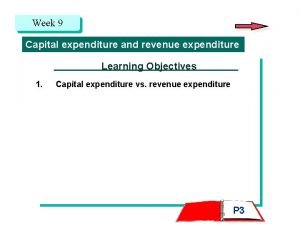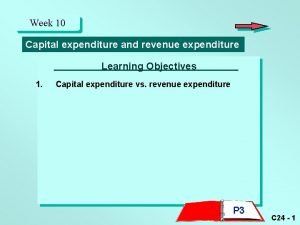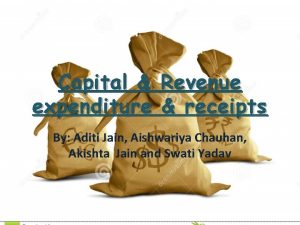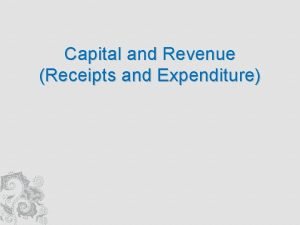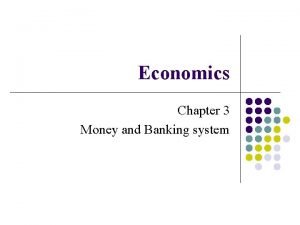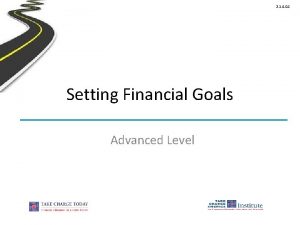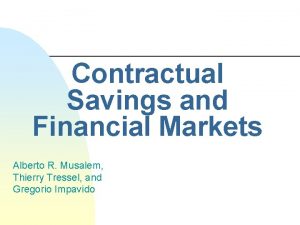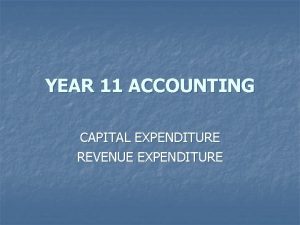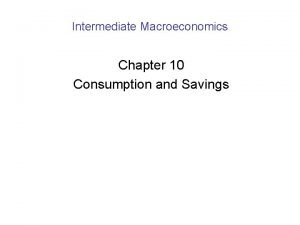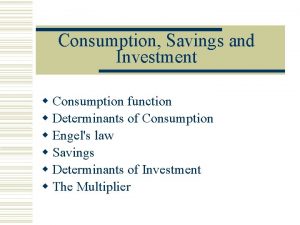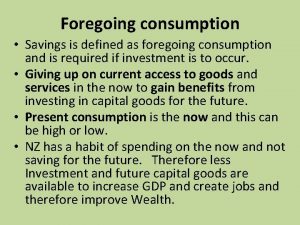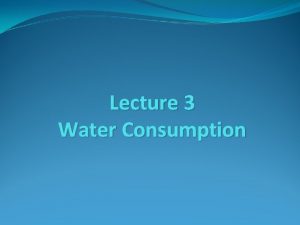CONSUMPTION SAVINGS Consumption Introduction Expenditure during a particular

















- Slides: 17

CONSUMPTION & SAVINGS

Consumption: Introduction: • Expenditure during a particular period on goods and services used in satisfaction of needs and wants. • Process in which the substance of a thing is completely destroyed, and/or incorporated or transformed into something else.

Consumption Definition: • The economic term ‘consumption’ means the amount spent on consumption at a given level of income. • ‘Consumption function’ or ‘propensity to consume’ means the whole of the schedule showing consumption expenditure at various levels of income. It tells us how consumption expenditure increases as income increases.

Consumption Function: • Propensity to consume is also called consumption function. • In the Keynesian theory, we are concerned not with the • • consumption of an individual consumer but with the sum total of consumption spending by all the individuals. Aggregate consumption depends on consumption function or propensity to consume. The consumption function or propensity to consume, therefore, indicates a functional relationship between the aggregates, viz. , total consumption expenditure and the gross national income • According to Keynesian theory, following are the factors that influence consumption: 1. The real income of the individual, 2. The past savings, and 3. Rate of interest.

Factors Influencing Consumption Function : • There are certain factors affecting the propensity to consume in the long-run: 1. Objective Factors: (a) Distribution of income (b) Fiscal policy: (c) Changes in business expectations (d) Windfall gains and losses (e) Liquidity preferences (f) Substantial changes in the rate of interest. 2. Subjective Factors: (a) Individual motives to save: (b) Business motives:

Keynes’ Law of Consumption: Keynes propounded a law based on the analysis of consumption function. This law is known as ‘Fundamental Law of Consumption’ or ‘Psychological Law of Consumption’. It states that aggregate consumption is a function of aggregate disposable income. Propositions of the Law: This law consists of three propositions: (a) When aggregate income increases, consumption expenditure will also increase but by a somewhat smaller amount. (b) When income increases, the increment of income will be divided in same proportion between saving and consumption. (c) As income increases, both consumption spending and saving go up.

SAVINGS

SAVINGS Introduction: • Saving generally means putting money aside, for example, by putting money in the bank or investing in a pension plan. • Saving is typically used to refer to cutting costs, or to rescuing someone or something. • In personal finance, saving refers to preserving money for future use - typically by putting it on deposit - this is distinct from investment where there is an element of risk. • Saving is a part of income which is not spend on consumption. Individual point of view • Aggregate saving is the part of national income which is not spend on consumption-Economy’s point of vies

• Saving differs from savings in that the first refers to • • • the act of putting aside money for future use, whereas the second refers to the money itself once saved. For example: you may decide to start saving 10% of your income; because you aim for your savings to grow into an amount sufficient to buy a car. Personal saving has been defined as personal disposable income minus personal expenditure. (Disposable income is gross income minus income tax on that income) In other words, income that is not consumed by immediately buying goods and services is saved.

Saving refers to an increase in one's assets, an increase in net worth Savings refers to one part of one's assets, usually deposits in savings accounts refers to an activity refers to something that occurring over time, a flow exists at any one time, a variable stock variable.

SAVINGS Definition: Acc to Keynes Saving defined as the excess of income over consumption expenditure. S = Y-C S-Savings Y= C+S Y-Income C= Y-S C-Consumption expenditure

SAVINGS Factors Determining the Size of Savings: 1. Size of Income 2. Spending 3. Govt. Policy -Fiscal & Monetary Policy -High Level of taxation 4. Price Level and Value of Money

SAVINGS Paradox of Thrift: 1. Classical economists- Saving a virtue & advocated thrift in the society 2. Individual save more- lead a prosperous life 3. Acc to keynes, savings reduces effective demand which will reduced the savings of the people. Different Approaches in the Concept of Savings:

SAVINGS Different Approaches in the Concept of Savings: Classical Analysis – Save More Keynesian Analysis – Save Less

(1) Saving and Income. A higher rate of interest will induce an individual to withdraw from (some) present consumption in favour of future consumption. In other words, at higher rate of interest more will be the amount of saving and vice versa. • The relation between interest and saving critically depends on the nature of individual’s preferences. • Increase in the rate of interest will enable the individuals to put aside a smaller sum every year and still reach the desired goal of saving a fixed sum.

(2) Saving and Taxation Policy. Taxes reduce the disposable income of the people and they have also to cut down their consumption. As a result, the level of compulsory saving increase in an economy. (Personal disposable income = PI - personal taxes (or) Personal disposable income = consumption + saving). (3) Saving (Social Insurance and Life Insurance). Deductions towards provident fund, insurance premium, etc. , from the money income also raise the level of saving.

(4) Saving and Distribution of Income Aggregate saving in an economy may depend, among other things, on the distribution of income. Since the marginal propensity to save of the rich persons is high, therefore, inequality of income will raise the level of saving in an economy. Reasonable distribution of income on the other hand, lowers the propensity to save.
 Difference between expense and expenditure
Difference between expense and expenditure Revenue expenditures
Revenue expenditures Capital reciepts
Capital reciepts Capital expenditures in accounting
Capital expenditures in accounting Geothermal desuperheater
Geothermal desuperheater Texas 529 plans
Texas 529 plans Annuity formula
Annuity formula 2 opt verfahren
2 opt verfahren Savings account java
Savings account java Icici savings suraksha
Icici savings suraksha Retirement savings percentile
Retirement savings percentile Demand deposit vs savings deposit
Demand deposit vs savings deposit Illinois bright directions
Illinois bright directions A measurable savings goal spells out ________.
A measurable savings goal spells out ________. Interior savings million dollar bursary
Interior savings million dollar bursary Crpc
Crpc Alberto musalem
Alberto musalem Chapter 5 savings accounts
Chapter 5 savings accounts
